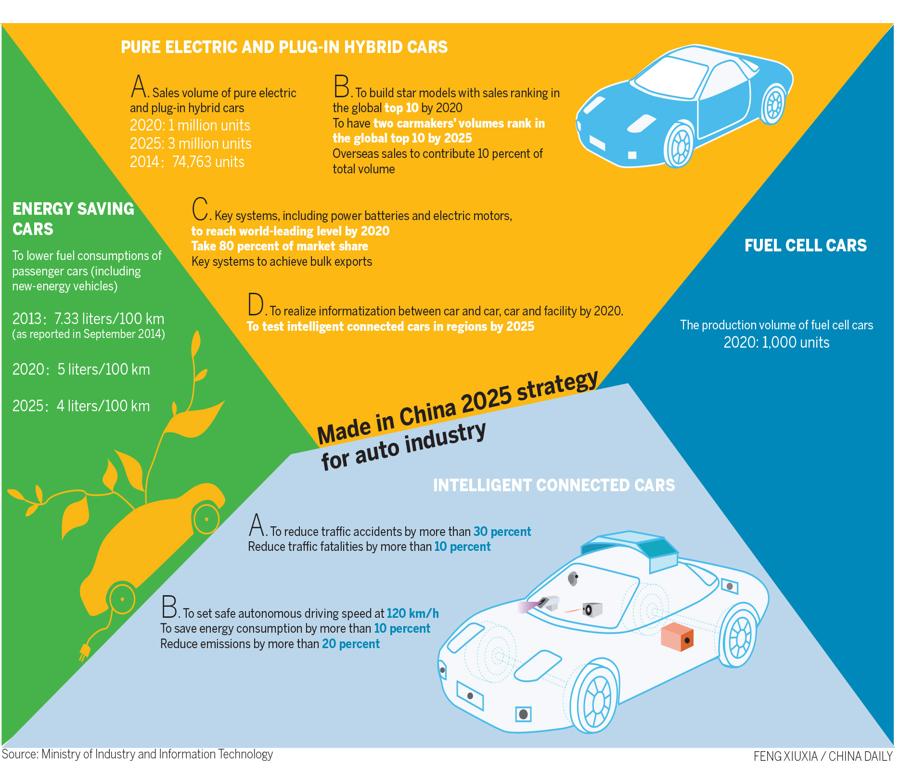Are China-Made Vehicles The Future Of The Auto Industry?

Table of Contents
The Rise of Chinese Automakers
The meteoric rise of Chinese automakers is undeniable. Fueled by government support and a focus on innovation, these companies are rapidly gaining market share both domestically and internationally.
Technological Advancements
Chinese automakers are making significant strides in electric vehicles (EVs), hybrid technology, and autonomous driving. This rapid technological advancement is a key driver of their success.
- BYD: A leading player in the EV market, BYD's Blade Battery technology offers superior energy density and safety features, surpassing many competitors.
- NIO: Known for its battery-swap technology and luxurious EVs, NIO is rapidly expanding its presence in international markets.
- XPeng: XPeng is at the forefront of autonomous driving technology, continuously pushing the boundaries of what's possible in driver-assistance systems.
- Government Support: The Chinese government provides substantial subsidies and incentives for the development and adoption of EVs and other advanced automotive technologies. This support has accelerated innovation and helped Chinese automakers compete on a global scale. This contrasts with the more piecemeal approach of many Western governments.
This rapid technological progress is directly challenging established players who are struggling to keep pace.
Competitive Pricing and Value
One of the key factors driving the success of China-made vehicles is their competitive pricing.
- Lower Manufacturing Costs: Lower labor costs and efficient manufacturing processes contribute significantly to lower prices.
- Economies of Scale: The vast domestic market allows Chinese automakers to achieve economies of scale, further reducing production costs.
- Price Comparisons: Many Chinese EVs offer comparable features to their Western counterparts at a significantly lower price point. This makes them highly attractive to budget-conscious consumers globally.
This affordability is a major factor in their ability to penetrate new markets.
Expanding Global Reach
Chinese car brands are increasingly visible in international markets, aggressively expanding their global reach.
- European Market Penetration: Several Chinese brands have successfully entered the European market, establishing dealerships and sales networks.
- Southeast Asian Expansion: China's proximity to Southeast Asia makes it a natural target for expansion, with many Chinese automakers establishing strong footholds in this region.
- Global Partnerships: Strategic partnerships and joint ventures with international companies are further accelerating their global expansion.
Challenges Facing Chinese Automakers
Despite their impressive growth, Chinese automakers still face significant challenges in their quest for global dominance.
Brand Perception and Trust
Overcoming negative perceptions about the quality and reliability of Chinese-made products remains a major hurdle.
- Building Brand Image: Chinese automakers are investing heavily in marketing and branding to improve their image and build consumer trust. This involves showcasing technological advancements and emphasizing quality control.
- Addressing Quality Concerns: Addressing past concerns about quality control and reliability is crucial for gaining consumer confidence. This requires a continued focus on rigorous testing and manufacturing standards.
- Long-term Warranty Programs: Offering extended warranties is proving an effective strategy in demonstrating confidence in the quality of their vehicles.
Regulatory Hurdles and Trade Barriers
Trade policies and regulations can significantly impact the expansion of Chinese automakers into foreign markets.
- Tariffs and Import Duties: High tariffs and import duties imposed by some countries increase the cost of Chinese vehicles, reducing their competitiveness.
- Safety and Emission Standards: Meeting varying safety and emission standards in different countries requires significant investment and adaptation.
- Navigating Trade Disputes: Geopolitical tensions and trade disputes can create uncertainty and hinder market access.
Supply Chain Vulnerabilities
Relying on specific supply chains or raw materials creates potential vulnerabilities.
- Geopolitical Risks: Disruptions caused by geopolitical instability or conflicts can severely impact the supply chain.
- Raw Material Dependence: Dependence on specific sources for raw materials, like lithium for batteries, can create price volatility and supply shortages.
- Supply Chain Diversification: Diversifying supply chains and securing alternative sources of raw materials are crucial for mitigating these risks.
The Future Landscape: Predicting the Role of China-Made Vehicles
The long-term prospects for China-made vehicles are positive, but several factors will shape their future role in the global auto industry.
Long-Term Growth Potential
Several factors point towards continued growth for the Chinese automotive industry.
- Global EV Demand: The increasing global demand for electric vehicles presents a significant opportunity for Chinese automakers.
- Government Policies: Continued government support and investment in the automotive sector will fuel further growth.
- Technological Innovation: Ongoing innovation in areas such as battery technology, autonomous driving, and connected car features will maintain their competitive edge. Market saturation will inevitably happen eventually, but this is not a concern for at least the next decade.
Collaboration and Competition
The future will likely see a mix of collaboration and competition between Chinese and international automakers.
- Joint Ventures: Joint ventures and strategic alliances will allow for the sharing of technology and resources.
- Technological Competition: Competition will be fierce, particularly in the development of advanced technologies like autonomous driving.
- Market Share Battles: Competition for market share will intensify, particularly in key regions like Europe and North America.
Environmental Impact and Sustainability
Chinese automakers are increasingly focusing on environmental concerns and sustainable manufacturing practices.
- EV Production: The emphasis on electric vehicles contributes to reducing carbon emissions.
- Renewable Energy Sources: Using renewable energy sources in manufacturing processes is a growing trend.
- Sustainable Materials: The use of recycled and sustainable materials in vehicle production is becoming more common.
Conclusion
The rise of China-made vehicles is a significant development in the global automotive industry. Their rapid technological advancements, competitive pricing, and expanding global reach present a formidable challenge to established automakers. While challenges remain in brand perception, regulatory hurdles, and supply chain vulnerabilities, the long-term growth potential of the Chinese automotive industry is substantial. The future landscape will likely be characterized by a mix of collaboration and competition, with China playing an increasingly prominent role in shaping the future of the auto industry. Stay informed about the future of the auto industry by researching the latest developments in China-made vehicles and their global expansion. Explore resources like industry reports from organizations like the International Energy Agency (IEA) and the Society of Automotive Engineers (SAE) to learn more about the evolution of this rapidly changing market.

Featured Posts
-
 Wildfire Speculation Examining The Market For Los Angeles Disaster Bets
Apr 26, 2025
Wildfire Speculation Examining The Market For Los Angeles Disaster Bets
Apr 26, 2025 -
 Why Current Stock Market Valuations Shouldnt Deter Investors A Bof A Analysis
Apr 26, 2025
Why Current Stock Market Valuations Shouldnt Deter Investors A Bof A Analysis
Apr 26, 2025 -
 Shedeur Sanders Nfl Draft Projection And Potential Giants Landing Spot
Apr 26, 2025
Shedeur Sanders Nfl Draft Projection And Potential Giants Landing Spot
Apr 26, 2025 -
 Indonesia To Export Rare Rice Varieties A Boost For Global Ties
Apr 26, 2025
Indonesia To Export Rare Rice Varieties A Boost For Global Ties
Apr 26, 2025 -
 The China Factor How Market Conditions Affect Premium Automakers Like Bmw And Porsche
Apr 26, 2025
The China Factor How Market Conditions Affect Premium Automakers Like Bmw And Porsche
Apr 26, 2025
Latest Posts
-
 Exclusive Nottingham Attack Survivors First Interview A Story Of Loss And Resilience
May 10, 2025
Exclusive Nottingham Attack Survivors First Interview A Story Of Loss And Resilience
May 10, 2025 -
 Investigation Launched Into Alleged Illegal Access Of Patient Data By Nhs Staff In Nottingham
May 10, 2025
Investigation Launched Into Alleged Illegal Access Of Patient Data By Nhs Staff In Nottingham
May 10, 2025 -
 Families Furious After Nhs Staff Accessed A And E Records Of Nottingham Stabbing Victims
May 10, 2025
Families Furious After Nhs Staff Accessed A And E Records Of Nottingham Stabbing Victims
May 10, 2025 -
 Data Breach Nhs Staff Allegedly Accessed Nottingham Stabbing Victims Medical Records Illegally
May 10, 2025
Data Breach Nhs Staff Allegedly Accessed Nottingham Stabbing Victims Medical Records Illegally
May 10, 2025 -
 Nottingham A And E Records Accessed Families Of Stabbing Victims Demand Answers
May 10, 2025
Nottingham A And E Records Accessed Families Of Stabbing Victims Demand Answers
May 10, 2025
